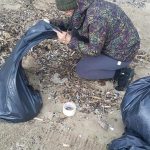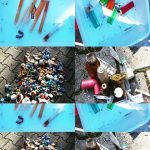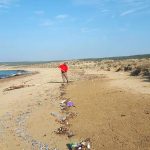
Karpasia beaches under threat of waste
Ronnas Beach, located on the Karpasia Peninsula, which is one of the most important breeding centers of sea turtles and is the third largest breeding area of green sea turtles in the Mediterranean, is facing the danger of extinction. As a result of 2 years of research on Ronnas Beach, an average of 1,114 pieces and 11.9 kilograms of waste per month were collected from an area of 250 square meters. These wastes originating from Lebanon, Syria, Israel and Egypt, which have the shores of the Mediterranean, pose a great threat to Ronnas Beach.
Waste originating from Lebanon, Syria, Israel and Egypt
In the project, where the source of the wastes was also investigated, it was determined that most of the wastes detected between January 2018 and January 2019 were from Lebanon, while the others were from Syria, Israel and Egypt. Near East University Faculty of Architecture Head of Landscape Architecture Department and TRNC Presidency Tourism and Environment Committee President Prof. Dr. Özge Özden informed that most of the waste reaching the shores of the TRNC from neighboring countries consists of plastic materials. Prof. Dr. Özden stated that they detected different wastes such as “detergent bottles, shampoo bottles, food and beverage containers”.
All over the world, plastic waste reaching the sea threatens the ecosystem by endangering the life of sea creatures. Prof. Dr. Özge Özden says that plastic waste threatens the lives of many marine animals, especially whales, sea turtles, dolphins, fish species and water birds.
Very urgent solid waste recycling projects should be developed in TRNC
Head of the Near East University Department of Landscape Architecture and also the President of the TRNC Presidency Tourism and Environment Committee, Prof. Dr. Özge Özden said that the results of the project also reveal the importance of solid waste recycling projects. Stating that the most important environmental problems in the world and in our country are domestic wastes, Prof. Dr. Özden emphasized that the accumulation in nature should be reduced by developing recycling projects for many wastes containing plastic, metal and glass.
Prof. Dr. Özge Özden: “96 percent of the waste polluting the beaches contains plastic.”
Near East University Head of Landscape Architecture Department Prof. Dr. Özge Özden said that, within the scope of the project, they regularly collect all marine wastes less than 2.5 centimeters in diameter every month from an area of 250 square meters determined on eight different beaches of the TRNC. A total of 59,556 pieces of waste were collected within the scope of the project. Among the different types of waste, the rate of plastic-containing wastes was found to be 96 percent. During the project, plastic bags, plastic parts, food and beverage containers and bottle caps were the most common wastes in terms of both weight and quantity.


